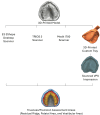Trueness and precision of complete denture digital impression compared to conventional impression: an in vitro study
- PMID: 40028199
- PMCID: PMC11871899
- DOI: 10.7717/peerj.19075
Trueness and precision of complete denture digital impression compared to conventional impression: an in vitro study
Abstract
Background: This study aimed to compare the precision and trueness of digital impressions of the edentulous arch made with different scanners to conventional physical impressions.
Methods: A total of 40 impressions of a completely edentulous maxillary arch model (n = 10) were made using different digital impressions with an extraoral scanner, E3 3Shape desktop scanner, as the reference scan, intraoral scanner (TRIOS IOS, and Medit IOS) and Vinyl Polysiloxane impressions (VPS) impression using a Computer-Aided Design and Computer-Aided Manufacturing (CAD-CAM) custom tray. The VPS impression was scanned with the desktop scanner to produce standard tessellation language (STL) files for comparison with the digital impressions made by the Desktop and intraoral scanners. The STL files were super-imposed to a desktop scan and to each other with the same group using Geomagic Control X Software to assess the trueness and precision, respectively. A t-test was conducted for statistical analysis with a significance level of 0.05.
Results: The overall trueness, Medit had the highest deviation compared to the VPS and TRIOS groups with a P value of 0.0013 and <0.0001, respectively. In terms of overall precision, TRIOS had a lower deviation than the VPS group, with a P value of 0.0002. The TRIOS and Medit groups had statistically comparable results. The desktop scanner showed the highest precision in digitizing completely edentulous cases, followed by the TRIOS scanner. The Medit scanner's trueness had the highest deviation compared to the VPS and TRIOS groups.
Keywords: CAD-CAM; Complete denture; Impression; Precision; Trueness.
© 2025 Al-Dulaijan et al.
Conflict of interest statement
The authors declare that they have no competing interests.
Figures



Similar articles
-
Trueness comparison of various intraoral scanners and hybrid workflow for ceramic restoration.J Appl Oral Sci. 2025 Aug 18;33:e20250065. doi: 10.1590/1678-7757-2025-0065. eCollection 2025. J Appl Oral Sci. 2025. PMID: 40834164
-
Impact of implant scan body material and angulation on the trueness and precision of digital implant impressions using four intraoral scanners-an in vitro study.BMC Oral Health. 2025 Jul 31;25(1):1288. doi: 10.1186/s12903-025-06502-4. BMC Oral Health. 2025. PMID: 40745640 Free PMC article.
-
Impact of operator experience, scanning pattern, and arch location on the time and trueness of complete denture digitization using an intraoral scanner.J Prosthet Dent. 2025 Aug;134(2):462-468. doi: 10.1016/j.prosdent.2025.03.022. Epub 2025 Apr 10. J Prosthet Dent. 2025. PMID: 40221369
-
Evaluation of the accuracy of intraoral scanners for complete-arch scanning: A systematic review and network meta-analysis.J Dent. 2023 Oct;137:104636. doi: 10.1016/j.jdent.2023.104636. Epub 2023 Jul 27. J Dent. 2023. PMID: 37516338
-
Final-impression techniques and materials for making complete and removable partial dentures.Cochrane Database Syst Rev. 2018 Apr 4;4(4):CD012256. doi: 10.1002/14651858.CD012256.pub2. Cochrane Database Syst Rev. 2018. PMID: 29617037 Free PMC article.
Cited by
-
Dimensional Accuracy Assessment of 3D-Printed Edentulous Jaw Models: A Comparative Analysis Using Three Laboratory Scanners.Materials (Basel). 2025 Jul 15;18(14):3323. doi: 10.3390/ma18143323. Materials (Basel). 2025. PMID: 40731532 Free PMC article.
References
Publication types
MeSH terms
Substances
LinkOut - more resources
Full Text Sources
Miscellaneous

